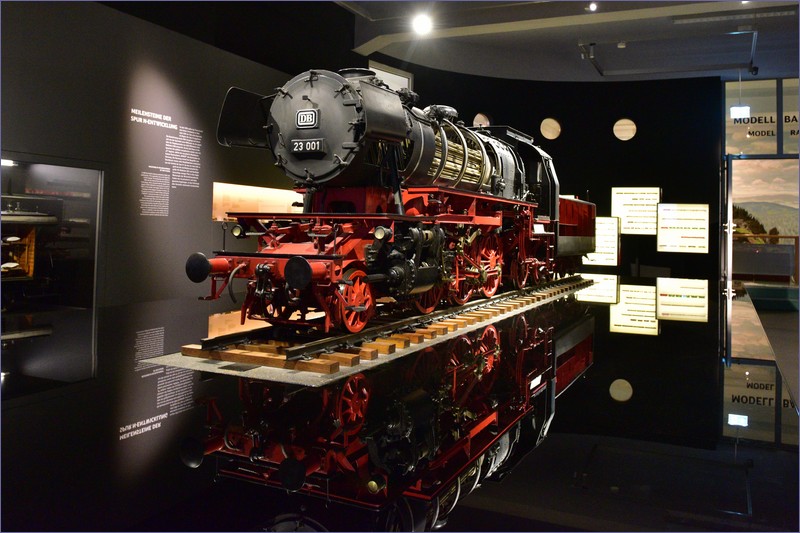There are four major railway museums in Germany (the museums in Berlin and Dresden are dedicated to public transportation generally, but have very good railway section). Most important and largest is the Deutsche Bahn Railway Museum in Nurmberg.
Germany is home to dozens of small, irregularly operating railway museums. This article briefly highlights only the most important railway museums in Germany that are a must-see.
Bahnpark in Augsburg – a relatively small museum compared to the others mentioned in this article, it is still worth a visit due to one of its exhibits. Most of the collection is housed in a locomotive shed built in 1906 by the Royal Bavarian State Railways. Other items are displayed in former workshops, with some exhibits outdoors.
The collection of displayed rail vehicles is impressive. Unlike other German museums, in Augsburg, you can see locomotives from various countries, such as the Netherlands and Austria. The most valuable exhibit is undoubtedly the Trans Europ Express, a luxury diesel multiple unit from 1957 intended for international services. For children, a short miniature railway line operates a few times a year. An additional attraction is a historic blacksmith’s shop.
Bahnpark in Augsburg – official website
German Museum of Technology in Berlin – a museum located in the center of Berlin, is a must-visit for railway and transport enthusiasts. The museum is extensive, housed in several buildings, with collections divided into thematic exhibitions, including railways, aviation, navigation, road traffic, and telecommunications. Additionally, you can see a reconstructed historic brewery.
The most interesting part – the railway section – features a variety of German rail vehicles. A total of 40 vehicles are displayed on 33 tracks, including steam, diesel, and electric locomotives, and carriages from different periods. Interiors of the most vehicles are accessible to visitors. A unique exhibit is the train used to transport Jews to concentration camps during World War II, with a part of the exhibition dedicated to this topic and the role of the railways in Holocaust.
The “Road Traffic” exhibition will interest many transport enthusiasts, showcasing over 200 cars, about 250 motorcycles, and more than 300 bicycles. The collection includes historic buses.
The museum is open from Tuesday to Sunday and is located at Trebbiner Strasse 9.
German Museum of Technology – offical website
Railway Museum in Bochum – Bochum is a typical industrial city with few tourists attractions. The city’s biggest attraction is the National Mining Museum, followed by the little-known Bochum Dahlhausen Railway Museum, located far from the city center.
The museum is one of the attractions on the Route of Industrial Heritage. It has an impressive collection of steam locomotives, including industrial locomotives designed to haul freight cars. Besides locomotives, there are a few passenger cars, historic railbuses, and technical vehicles on display.
On selected days, museum-owned locomotives haul retro trains on the Ruhr Valley Railway line between Düsseldorf, Bochum, and Hagen (various routes depending on the day). Parts of the line are closed to regular passenger services, making special trains the only opportunity to travel these sections.
Railway Museum in Bochum – official website
Transport Museum in Dresden – the museum in Dresden is smaller than the one in Berlin but is also very popular among tourists. Located in the city center, at Neumarkt, it is divided into permanent thematic exhibitions, including railways, road traffic, aviation, navigation, and model railways.
The railway exhibition presents the history of railways in Saxony from the beginnings to 1993. Besides carriages and locomotives, it displays railway uniforms and models. Notable exhibits include “Muldenthal,” the oldest original German steam locomotive (1861), and a replica of the early mining railway. The main museum building houses only eight rail vehicles, with many more kept elsewhere.
A part of the museum is the locomotive shed, where 105 historic rail vehicles are stored, including steam locomotives, diesel locomotives, historic carriages, and technical vehicles. Most have been restored. Museum-owned vehicles can be seen during retro train rides organized by railway enthusiasts’ associations, as the museum leases out operational stock to event organizers. It’s unclear if the locomotive shed is open daily.
Transport Museum in Dresden – official website
Deutsche Bahn Museum in Nuremberg – the Railway Museum in Nuremberg has a long and eventful history. Founded in 1899 as the Royal Bavarian Railway Museum, it has changed names several times throughout its existence. It was destroyed during World War II air raids. Since 1996, the railway section of the transport museum has been managed by Deutsche Bahn. In 2005, a fire in one of the museum halls destroyed numerous unique exhibits, including a replica of the Adler train, which operated on Germany’s first railway line between Nuremberg and Fürth. The replica was rebuilt and made available to visitors in 2007.
In 2012, the museum underwent renovations to enhance the visitor experience, including interactive features such as switching semaphores.
Visitors can explore permanent exhibitions on the history of railways in Germany, divided into several periods, a display resembling a train station, and the most attractive exhibits – historic trains, locomotives, and carriages (originals and replicas). The royal train of King Ludwig II of Bavaria is particularly popular.
The museum also features impressive model railways. The Deutsche Bahn Museum has two small branches – in Koblenz and Halle. It also manages several retro trains operating a few times a year across Germany.
The Deutsche Bahn Museum is located in central Nuremberg, very close to the main railway station. It is open from Tuesday to Sunday, and during the Christmas market and International Toy Fair, it is also open on Mondays.
Admission is charged, and Deutsche Bahn tickets entitle visitors to a discount.
Deutsche Bahn Museum – official website
Related articles:
Train travel in Germany – a comprehensive guide
